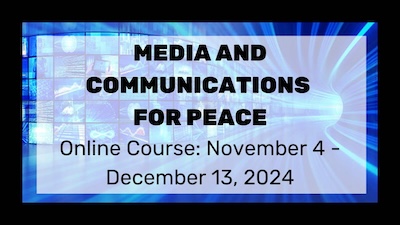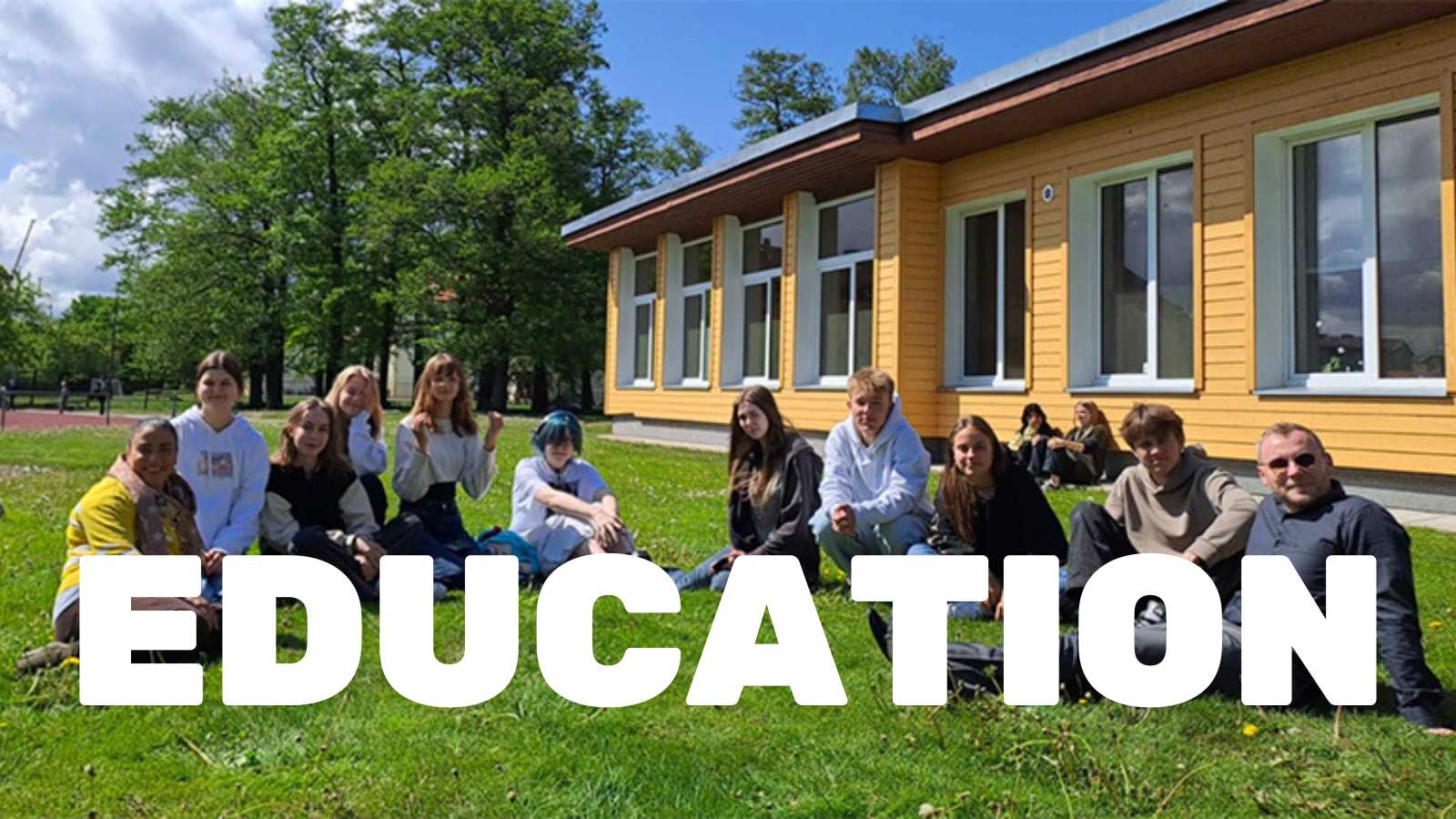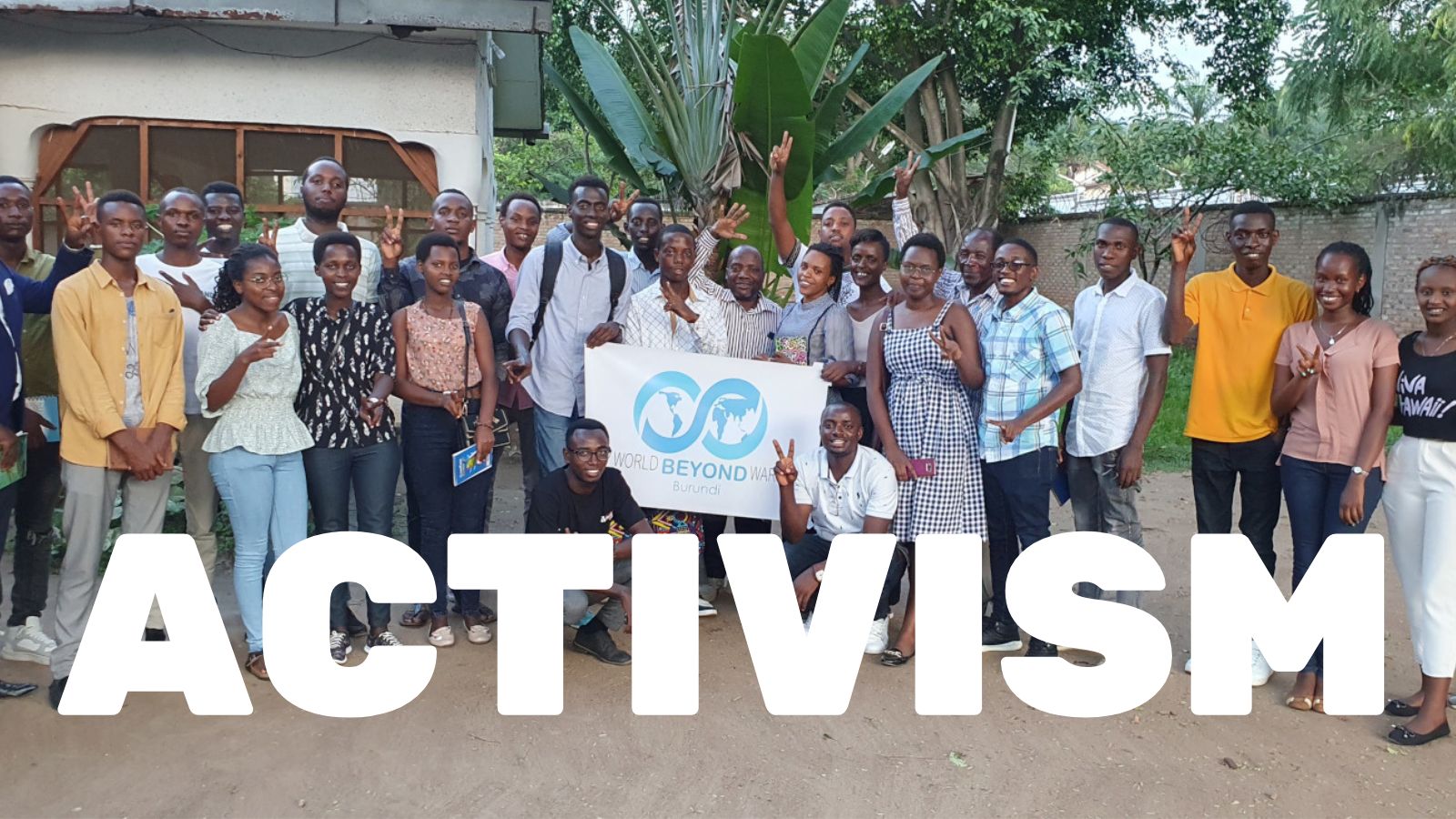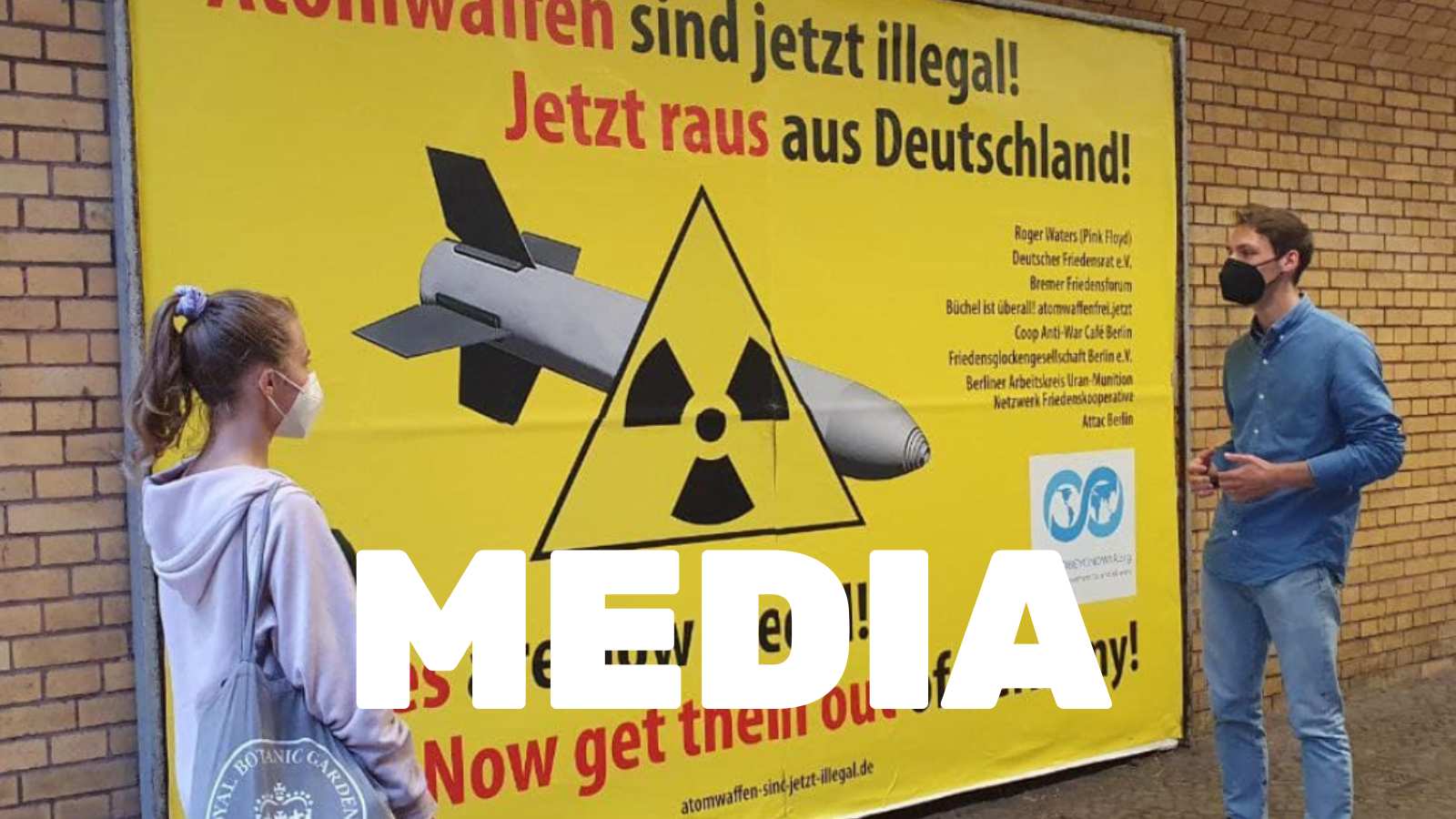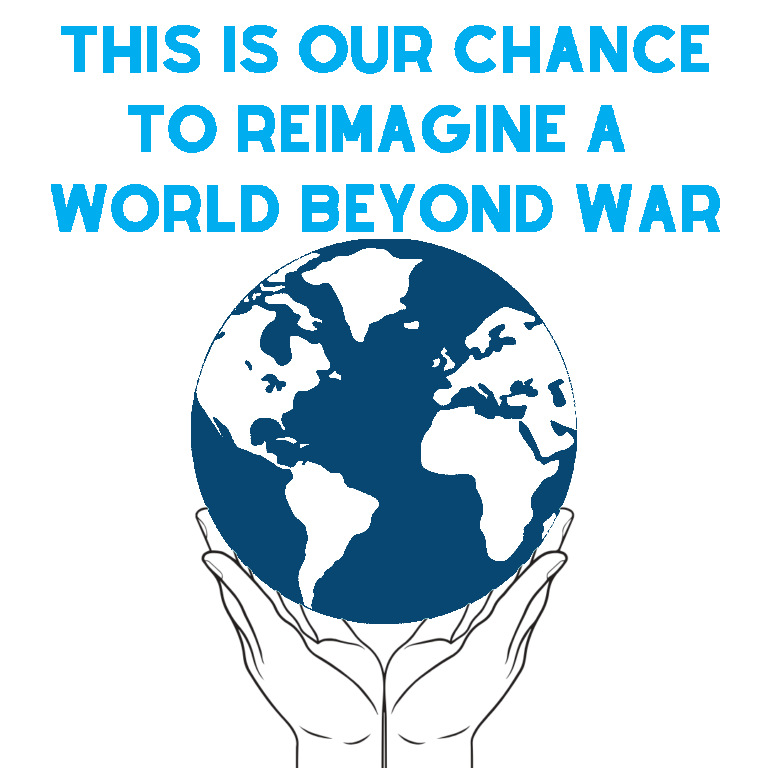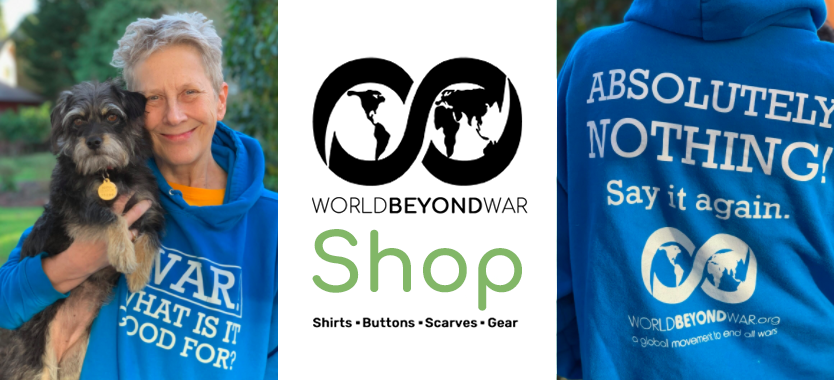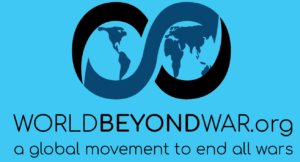 I’m inspired by a quote attributed to the great South African leader recently lost to us, Nelson Mandela: “It always seems impossible, until it is done.”
I’m inspired by a quote attributed to the great South African leader recently lost to us, Nelson Mandela: “It always seems impossible, until it is done.”
We’re addicted to many forms of violence, and war is arguably our greatest violence against each other. For everyone who would love to see us in a human future where a few no longer rule the many by force, where we don’t destroy the physical works of our labors—the beautiful things we create. Where we don’t kill our children both physically and spiritually. I’m here because I believe I can convince you, that we now have an opportunity to end our addiction to this very bad habit.
 I’ve spent most of my adult life studying animal behavior, including human behavior, and two things are clear about war. First, that the overwhelming majority of people from all cultures prefer to live in peace. At the deepest level of our being, people hate war. Whatever our culture, we share a desire for the good life, which most of us define as having a family, raising children and watching them grow into successful adults, and doing work that we find meaningful. And war grotesquely interferes with those desires.
I’ve spent most of my adult life studying animal behavior, including human behavior, and two things are clear about war. First, that the overwhelming majority of people from all cultures prefer to live in peace. At the deepest level of our being, people hate war. Whatever our culture, we share a desire for the good life, which most of us define as having a family, raising children and watching them grow into successful adults, and doing work that we find meaningful. And war grotesquely interferes with those desires.
And second, studies of biology and anthropology increasingly indicate that we can put an end to war….if we choose to do so.
 I’ve even had the audacity to create an Action Plan for a movement that can free us. There are many others who are exploring visions for how to cure us. I put the pieces of a plan together for a conference on moving beyond war sponsored by the Nobel Women’s Initiative. It was held in Belfast, Northern Ireland in late May of last year, scarcely eight months ago.
I’ve even had the audacity to create an Action Plan for a movement that can free us. There are many others who are exploring visions for how to cure us. I put the pieces of a plan together for a conference on moving beyond war sponsored by the Nobel Women’s Initiative. It was held in Belfast, Northern Ireland in late May of last year, scarcely eight months ago.
Some very good news I can share is that as recently as two months ago, I found people with experience and passion who’ve joined in a partnership to work out a finished plan to end war and put it into action. I’ll be glad to share more about them and their website, WorldBeyondWar.org.
An Epiphany in Belfast
In Belfast, I had an epiphany. It didn’t occur in my morning shower, where I experience a lot of insights. Rather, I spoke with the great Nobel Peace Prize Laureate and peace activist Mairead Maguire. Along with Betty Williams, Mairead won the Nobel in 1976 for her work in securing the Peace Agreement in Northern Ireland.
She asked me to tell her about my work, and during the entire conversation, she asked only one question: How? How do we end war? I believe she was asking, “I’ve been at this for years. How do we do what I have not yet been able to do? How do we do what no people before us have been able to do?””
My epiphany was that I had recently spoken with two other long-time peace activists, and in their own way each had asked the same question: how? These good people have worked to end war for years and years….and they were, and are, stymied. They’ve been unable to find a way to break through the enormous barriers that keep us locked in cycles of violence.
So I was delighted when she posed that question, because that’s what I’ve been pondering for approaching twelve years now. What I’m sharing here is what I proposed to her in shorter form, for how we can actually move forward.
First and foremost, I firmly believe that if earth’s citizens are given a vision for how a great, cultural transformation that abolishes war can be achieved, the necessary critical mass of people can be moved from their homes into the streets and into halls of government to declare that they will no longer tolerate war, and to demand that nonviolent means alone be used to solve our serious conflicts.
I’m hoping you’ll take away two things from this talk. A feeling and a sense. The feeling that united, we can succeed! And a sense of HOW we can do it.
The Need to Act is Urgent
I’m not going to spend a lot of words explaining why the need to act is urgent. You’re here, so you are likely as aware as I am that our planet is full to the brim with us, that there is nowhere in the foreseeable future to which we could emigrate to escape from each other. And we’re faced, right now, with extraordinary threats from global climate changes, threats of nuclear, biological or chemical disasters, or epidemics that could undo civilization as we know it.
A recent film starred Matt Damon and was called Elysium. It depicts an Earth where the many live lives of despair on a ruined planet while the very rich live in unimaginable comfort and health on Elysium, a satellite in space. Continuing to devote money and time to war has become a certifiable form of social insanity. If we continue our business-of-life as usual, the people that inherit the future we leave behind may very well detest us.
Why Our Time in History is Poised to Succeed
Now before outlining a possible ending-war plan, I want to indicate several reasons why our time is uniquely poised to bring off a huge social transformation on the scale of ending war…if you will, a Great Paradigm Shift. We need to understand why we are equipped for success when others could not succeed. I see six major social/cultural events that have created an opportunity for us to seize. These go back roughly 700 years. So, a lot of people have done a lot of preparatory work before us.

- First, the Renaissance, Reformation, and Enlightenment – these took off roughly 700 years ago. They brought huge cultural changes. Among these, they led to a recognition of the worth of individuals: a person was no longer considered a possession or tool of a king or necessarily subservient to religious authorities. People began to see the need to think for themselves. Also, the rise of reason and the flourishing of romanticism during the Enlightenment stressed the critical war-ending values of human rights and of love and empathy.
- Second came the modern scientific method, roughly 300 years ago. This led to the –ologies: zoology, anthropology, archaeology, biology, primatology, psychology …the labors of thousands of people dedicated to the search for knowledge has enabled us to know our nature. Specifically relevant to this subject, we know why we make war…that it is not our genetic destiny. And this knowledge is key to our accepting that we can put an end to it.
- Then came the return to democracy as a form of government, sadly birthed at the cost of a great deal of blood as exemplified by the English, French, and American Revolutions. As it relates to war, democracy is the best method we’ve devised thus far to restrain warmongers. It’s no guarantee that war will be rejected as a political tool, but it is more difficult for leaders in a democracy to mobilize people for war than for a tyrant or king to simply declare one. Recently, we’ve also learned that just giving people the vote is woefully insufficient to produce significant positive change…we need liberal democracies. A liberal democracy is characterized by the rule of law, free and independent presses, separation of church and state, an educated citizenry, social justice, and a respect for human rights.
- It was only roughly 100 years ago that the enfranchisement of women began in a significant numbers of countries. This was, by the way, as truly a slippery slope as many men, and even women, feared it would be. If you’ll pardon the pun, this was perhaps the “mother” of all slippery slopes. Because when enfranchisement develops to its full potential, it enables a strong female influence on governance. Increasingly, studies indicate that where women are influential in a society, the rates of not just corruption go down, but also rates of internal and external wars. A recent excellent book, with the titillating title “Sex and World Peace,” is actually a very serious work. It presents convincing amounts of data on the positive role of women to reducing violence. I have described in a previous work, and in a recent book, Shift: The Beginning of War, The Ending of War, why women biologically are more concerned than are men to reduce violence and create stable communities in which to raise their biologically “expensive” children.
- Just fifty years ago the development of reliable forms of birth control and family planning was another pivotal ending-war change because these facilitate the empowerment of women. When women can decide when and how many children to have, they can participate more fully in public affairs….like decisions about how to run a government, what to spend money on, and whether or not to go to war. Again, women’s preference to avoid the physical violence of war is primed now to influence decisions about war as more and more women take roles of leadership.
- Finally comes the world-changing development of the Internet. This facilitates instant global communications, for better or worse. The rise of international terrorism is unfortunately facilitated by it. But…we too can use it in a campaign to end war that must be global in scope.
I may have left out some things, but clearly the point is that our time is history is RADICALLY different from any that preceded us…and different in ways that create this window of opportunity to end war. One of the things an ending war movement can do is make the world’s citizens aware of just how wonderfully poised we are to make a Great and Positive Shift.
The Next Great Human Revolution
Now let’s put what we propose to do into an even more sweeping historical context. This lets us see not only that Great Shifts are possible, but also we can begin to envision the next possible positive advance in the human story on earth. Arguably, there have been four previous great cultural revolutions:
- First, was the Mastery of Fire – controlling fire allowed us to eat a greater variety of foods and deal much more effectively with adverse weather. Those benefits facilitated an expansion of the range of places we could live. Roughly 60,000 years ago, our species left Africa, and we now have reached virtually every region of the planet.
- Then about 10,000 YA came the Agricultural Revolution – the domestication of plants and animals allowed for larger communities, new social niches and work specializations, and the rise of civilizations.
- [The Industrial Revolution] – Things remained relatively unchanged for several thousands of years, until roughly the beginning of the WOW change of the Industrial Revolution. We harnessed the energy of electricity, sufficient energy to build monumental structures, to create higher standards of living and new forms of transportation, and lay the foundation for the next great shift, which then happened in a relatively eye-blink of time, the
- Digital Revolution – this has put us on the moon, given us instant global communication, and allowed us to build the most monumental project we’ve yet attempted, an atom smasher, the Large Hadron Collider, near Geneva, Switzerland. Last year teams of scientists established the existence of a tiny cosmic force, the Higgs’s Boson, what some people have called the God particle.We now have what our nomadic-forager ancestors would consider godlike abilities.There is a quote often attributed to Albert Einstein:
It has become appallingly obvious that our technology has exceeded our humanity.
It’s time for a new Great Revolution, a Nonviolence Revolution. We deserve a worldview shift that facilitates an upgrading—a flourishing—of our moral sensibilities so they better match our astounding technological capacities. A global nonviolence revolution would be a change—a paradigm shift—in how people view conflict.
Conflicts would certainly not cease—if even just two people are living together, say husband and wife, there will be conflicts—but when this revolution takes hold, the idea of using a war to resolve differences would at first be forbidden by law, then by custom, and in time it would become unthinkable.
The engine that can propel such a stunning change in worldview, I argue, is a campaign to end war.
A Campaign to End War as an Engine Driving a Nonviolence Paradigm Shift
Why is that so? I’ll offer four reasons.
The first way such a campaign would fuel a nonviolence worldview shift is that it would be above all an awareness movement. It tells all the people of the world— using every kind of media available—that contrary to what they believe, scientists as well as philosophers, political leaders and lay workers have discovered that war is NOT an inescapable human burden, not something built into our genes. So right away we would generate a new way for people to think about the use of violence, including the violence of war. The begin to see it as something from which we might actually escape.
Second, an ending-war campaign tells our children that we no longer accept or tolerate killing for any reason, no matter how serious the problem may seem to be. As a campaign to end war works and struggles, we’ll instill in children our realistic vision of a very different kind of world and future, one without the violence of war, and with the potential to reduce all kinds of violence.
Third, because our children are our future, they will build on the reality the movement creates. By our example, they’ll learn the skills of nonviolence, how to build and maintain a nonviolent society…because a movement to end the violence of war must use only nonviolent tactics. Some people are skeptical of the efficacy of nonviolence to bring about change. I highly recommend a YouTube TED talk by political scientist Erica Chenowith on the power and success of bringing about positive change using nonviolent means vs. force. It seems there really is no contest. Nonviolent movements are significantly more successful and lasting
Fourth, increasing successes—small conflicts halted, weapon systems put into mothballs, country after country adopting a nonmilitarized status, and so on—these will free up resources now dedicated to manufacturing and selling weapons, waging wars, and cleaning up after wars—resources freed up for desperately needed better things. With peace systems established in first one arena and then another, which brings stability to communities and countries, we can devote far more attention and resources to reducing other forms of violence, from gang wars to domestic abuse.
So a campaign to end war is about much more than ending war. It is action to erect a foundation of stable communities within which we can reap the rewards of peace into our far distant future. Think of a campaign to end war as a team of horses that will pull a wagon full of many positive payoffs.
The Potential for Rapid Change
How long will it take to achieve the goal of no ongoing wars? When I began this work, a dear niece said she loved the idea, but that she couldn’t get involved because she was, and I quote her, “too busy raising my two boys, and ending war would take hundreds of years.” My first thought was that someday her sweet boys might be sent to war or be destroyed by one that might have been prevented…had she joined with thousands of others to end wars.
But my second thought was that she was wrong. It’s simply a fact that when conditions favor it, human cultures can transform rapidly. Consider a recent major event, the formation of the European Union. One of the main goals was to stop the cycle of centuries of wars. It is now virtually unthinkable that Germany and France would declare war on each other. Other examples of rapid change are the fall of the Berlin Wall and the flowering of democracy in Tunisia.
With the tools now available to us, if we apply financial and human resources, and vision, we could absolutely change the global community’s view about the legitimacy of and use of war easily within two generations.
And it’s also entirely possible that the demise of war could come even more swiftly. We’re all familiar with the principles of “critical mass” and “tipping point.” In sociology, tipping point is defined as “a point in time when a group —or a large number of group members— rapidly and dramatically changes behavior by widely adopting a previously rare practice”….in this case, the all too rare practice of total nonviolence for resolving serious conflicts between groups. A point where “the levels at which the momentum for change becomes unstoppable.”
Examples of tipping points are bank runs, strikes, migrations, riots, and revolutions. In retrospect, such events are explainable. But in prospect, their timing and nature are impossible to predict. Such events seem to come closer and closer but don’t occur, even when conditions seem ripe for them to happen—until suddenly they do.
Arguably, conditions around the globe are “ripe” for abolishing war. In which case, as a 1970 movie suggested, the global community could quickly arrive at a moment when warmongers somewhere announce a war, and nobody comes. Indeed, where the global community puts an immediate halt to any use of weapons.
Five Necessary Prerequisites for Ending War
So now we’re prepared to consider that “how” question Mairead Maguire asked me, the “how” of abolishing war. I’ve shared the results of years of study in my book, Shift, The Beginning of War, The Ending of War. Essays on my website, www.AFutureWithoutWar.org, include my Action Plan.
The plan begins by listing five prerequisites that must be in place before a campaign is able to take off:

- First and foremost, all who join the movement must hold in their minds and especially in their hearts the deeply held conviction that the goal is achievable. Without genuine belief in the possibility of ending war, no movement will likely begin, and it certainly won’t be sustained against inevitable disappointments, setbacks, and pushback—major pushback— from the war industry.
- Second, there must be a plan: strategy and tactics for how the campaign proposes to challenge the war machine. History shows that war won’t stop just because we want it to, but I believe neither will it be defeated by means of some indirect actions. Using a military analogy, a direct attack on the machine of war is required.
- Third, there must be leaders who become unreservedly committed to executing the plan. In the words of the U.S. Declaration of Independence, they must pledge to each other their lives, their fortunes, and their sacred honor to make this thing a reality.
- There must be a critical mass of global citizens who want the shift and are willing to do the work required.
- And finally, at the outset of a campaign, a core of workers must be dedicated solely to facilitating the plan’s execution.
At some level these prerequisites are, or nearly are, in place. This includes the potential I see in the effort under way mentioned earlier, World Beyond War.
The Two Major Components of the Action Plan
If we analyze the types of actions that have to be part of the plan, there are two different kinds. Mohandas Gandhi, the great theorist and strategist of nonviolent social transformation, saw his efforts as composed of two complimentary approaches: Constructive Programs and Obstructive Programs.
For Gandhi, Constructive Programs were things like teaching villagers to be independent by spinning their own cloth, and working to end the worst excesses of the Indian caste system. If you will, think of Constructive Programs as good works that lay the foundation on which the transformed society is to be built.
The kinds of Constructive Programs I see being pursued around the globe right now are legion. They deal with multiple causes of wars and are things like
- peace-education programs,
- peace-building efforts,
- post-conflict reconciliation programs,
- programs to end poverty,
- to provide essential resources such as adequate health care and education to all global citizens,
- to spread systems of governance like liberal democracies that respect human rights and dignity,
- to spread knowledge and practice of sustainable living so adequate essential resources are available for everyone,
- to foster connectedness among all people by stressing the oneness of our humanity.These are all examples of Constructive Programs—of good works. In my own work, for convenience I group these many things into nine categories. I call them cornerstones for ending war and maintaining an enduring peace.History suggests strongly, though, that when it comes to taking down the war machine, these good works are “necessary but not sufficient.” None of them alone can abolish war, and I believe even in combination—were they perfectly coordinated—they do not have sufficient clout to eradicate the war machine.
An understanding of human biology indicates that a behavior like war, that has tentacles in so many aspects of our histories, cultures, lives, entertainment, and economics won’t be defeated using good works alone. The war business machine is perfectly capable of letting us teach peace and strive to end poverty and advance human rights generation after generation while it grinds on…sucking up resources.
Now Obstructive Programs, on the other hand, have teeth. They depend on the power of nonviolent direct action. They rely on the “soul force” of people power. Gandhi called his Obstructive Program satyagraha. It’s also called nonviolent civil disobedience, or nonviolent struggle. The many tactics are things like boycotts, sit- ins, strikes, marches, refusing to conform to unjust laws or to participate in immoral behavior.
It’s the united application of Obstructive Programs in synergy with Constructive Programs that can end war.
 United—all of us, using Constructive and Obstructive Programs, we have the potential to succeed.
United—all of us, using Constructive and Obstructive Programs, we have the potential to succeed.
The strategy behind Obstructive approaches requires that a movement’s leaders develop a clear picture of the evil to be dislodged—namely the war system—and then develop tactics to directly challenge it. Until recently, as I looked around the globe I didn’t see a clearly and compellingly articulated plan that uses both Constructive Programs and Obstructive Programs that was of sufficient size to genuinely threaten the war system – although as I’ve mentioned, World Beyond War is showing great promise.
But the reality right now as I see it is that the people power forces that could succeed are splintered and are consequently not up to this monumental task. “Divide and conquer” has been working for the war machine for a very long time. This is why activists like Mairead Maguire are stymied.
So is there a way to unite them and give them—give us!—a powerful voice? I believe there is. Jody Williams won the Peace Prize in 1997 for her work with the International Committee to Ban Landmines. The ICBL pioneered a way to unite many organizations which had, initially, no concern with landmines. It united them into a coalition with sufficient leverage to secure a treaty to eliminate landmine use. Ms. Williams called this mechanism “massively distributed collaboration.”
When I read that phrase, a big AH –HA moment struck. “Massively distributed collaboration.” That was the key. I poured over her book, Banning Landmines: Disarmament, Citizen Diplomacy and Human Security. In it I found a successful model that could be scaled up for the people’s campaign to end war.
To Succeed a Global Movement Must Be Broadly Inclusive and United
But here’s a big problem. How do you persuade all people of the world to overlook their many differences, viewpoints, and opinions to unite behind this one great effort? Because power to bring about change in something as massive as the war system lies in unity and in numbers. To succeed, all global citizens would need to be attracted to the cause. See it as worthy of their attention. Their contributions. Their participation. Liberals and conservatives, Jews and Muslims, religious believers and atheists, communists and capitalists, rich and poor. All would be invited to join in a great, history-changing common cause from which we would all benefit.
So what is something that all people have in common? Something that doesn’t need to be taught because it’s part of our natural heritage. What is something that could be a global movement’s common touchstone?
That “innate thing” is love for children. Humans not only love their own children, we have this wonderful, built-in tendency to love and want to care for even children
who are not our own. When asked what is our mission, we’d say “we do this work to give our children safe, secure communities in which to grow up and reach their full life potential.”
Consider also that all great social movements have factions. Not all women agreed on how to win the vote for women in the United States. Not all African Americans in the United States agreed on how to end segregation in public services and housing. When one reads about Gandhi’s work, it’s clear that his struggle included efforts to keep many different groups with different agendas united behind a shared vision to achieve Indian independence.
But what is clear is that such movements achieved their greatest persuasive power when they found ways to put differences aside and unite in common purpose behind wise leadership that enabled them to “keep their eyes on the prize,” not on differences that might divide them.
The Essentials of a Global Movement to Abolish War
The movement would carry out its work using the “soul force” of united people power to apply pressure to weak points of the war machine, systematically take it apart, piece-by-piece. “Weak points” refers to actions or programs of the war machine that are 1) clearly considered immoral by great numbers of people, so that the people’s movement occupies the moral high ground, and 2) they are the most susceptible to prevention, elimination, change, or termination. Examples would be the use of aerial killer drones, nuclear weapons, landmines, placing offensive weapons overhead in space, rape as a war tactic, forcing children to participate in war, an actual war (particularly a small one), a war on the verge of breaking out, and so on.
Here are three of the basics of how a global movement could be structured and function, taken from the ICBL playbook:
- First, no dues would be required to join, only the willingness to participate. Continued membership, however, would depend on participation, not just signing your name. The numbers of individuals and organizations globally who are potential partners because they would benefit by ending war is in the many hundreds of thousands, potentially millions. As a friend of mine put it, united they would rapidly outnumber all the armies of the world.
- Second, no bureaucratic structure would dictate how partners contribute. Members would conduct efforts that fit their own mission, their political culture, and their circumstances. For example, if once organized the movement chose to focus first on the establishment of a treaty to ban use of killer drones, and it picked as its shared action a particular day of each month for six months to focus the global communities’ attention on that issue, the member partners would do whatever they could, large or small, to bring attention in their own sphere of influence on that same day. They might organize a concert. Produce a play. Plan a march, sit-in, pray-in or boycott. Ideally, whatever would attract media attention, spread the message, and intrigue potential recruits.
- And third—and very important—whatever they are already doing as part of Constructive Program—whatever you or your organization is doing—would continue. Each partner—individual or organization—just contributes whatever time and resources they can spare to add their “people power” to whatever the entire movement has chosen to focus on with respect to the war machine.
The simple beauty of this concept is that the world senses, and sees at work, a mighty entity that has rejected war and is acting to abolish it.
The Foundation Cornerstones of Enduring Peace
Now moving ahead, let’s assume that in the not too distant future we succeed. There are, in fact, no ongoing wars. The world community is not without its conflicts, but it has embraced a peace system that allows for resolution of conflicts through law and courts and the known nonviolent means, not bullets and bombs.
The challenge will then be to prevent backsliding. To ensure that the peace system doesn’t unravel because of some new pressures. How do we ensure that the world’s peace system, or systems, works well enough to catch incipient warmongers in the act, and prevent war from breaking out?
Now we return to Constructive Programs. They are foundations of enduring peace because they address fundamental problems of living in large social groups. They address human biology and needs. They recognize why we’re susceptible to making war, even when most people hate war. They address biological tendencies that make us susceptible to the wiles of warmongers. They provide life essentials that, when lacking, cause people to take up weapons. Working on these Constructive Program cornerstones is necessary to create a future without war. But attending to them in perpetuity will be key to maintaining enduring peace.
To simply describe how cornerstones fit into the campaign would require at a weekend workshop. Each embraces hundreds of programs and efforts. When I write or talk about them, I list them in alphabetical order to help me remember all nine categories.
I want to quickly list them for you. You’ll probably find it easy to imagine the kinds of programs or efforts they include. Maybe you’ll even see right away where your own major concern (or concerns) is directed.

Here are their names:
Embrace the Goal – this is a cornerstone where the work is dedicated to promoting the goal of ending war, including convincing people it’s possible. My work fits here.
Empower Women – these projects promote the status of women as leaders, to deploy their innate inclinations to create secure and stable communities for their children.
Enlist Young Men – to make them a part of the solution, because troubled young men are a substantial risk to social stability.
Ensure Essential Resources – food, water, shelter, health care, education – people without these eventually become susceptible to warmongers
Foster Connectedness – to Mother earth, for ecological and sustainability reasons, and to each other – to foster the sense of human oneness which blunts a warmongers ability to convince us to kill other people.
Promote Nonviolent Conflict Resolution – these teach the practice and techniques— the art—of nonviolence, peace-living, and peace-building.
Provide Security and Order – address issues of policing and maintaining social order, locally and globally; promoting human rights, law, and justice; where there is no security and order in our communities, we can’t fully achieve or maintain any of our other goals
Shift Our Economies – they must be made sustainable and just
Spread Liberal Democracy – free press, independent judiciary, respect for human rights, egalitarian governing.
When these concerns are listed this way it becomes very obvious why one reason ending war is an enormous ambition, not achieved so far, is because all of these must be tackled and achieved at a level sufficient to prevent war. A clearly enormous challenge.
A plus of listing them is that reflection begins to suggest new ways the groups involved in them might function synergistically, not separately, thus facilitating a rapid worldview shift away from war.
The great good news of course is that hundreds of thousands of individuals and organizations—north and south, west and east—hundreds of thousands of us are already at work….although the vast majority don’t likely see themselves as essential components of a campaign to end war. They don’t think of themselves that way. But they need to.
And they all need to be saying: “Ending war is possible. We’re going to make it happen. We have a plan. We’re succeeding. Join us!”
Conclusion
So in summary, what do we need to foster history’s next great revolution?
We need leaders from all aspects of human endeavors who have a shared vision of a nonviolent future and the determination to proceed: teachers, students, philosophers, artists, scholars, politicians, futurists, inventers, social transformation activists, media experts, security experts, conflict resolution experts, adventurers.
Three notable such individuals are here with us.
Dr. Douglas Fry, a scholar who has challenged the long-standing, erroneous belief that humans are inherently warlike, and has outlined the features of peace systems.
Krzysztof Wodiczko, who uses his extraordinary art to bring to our awareness the evils of a variety of social ills, including the horrible damages and waste of war.
And John Horgan, a journalist who is an expert in using media to communicate ideas like the possibility that we can end war, and who has given voice to scholars like Dr. Fry.
Which brings us to the rest of us. The most important key players are the world’s people. Given the vision of a real possibility of ending war, and united by facilitators who enable them to coordinate their efforts, the world’s people will be the force that gives life to an abolition movement. Everyone in this audience has talents and experience that would be invaluable.
To repeat, I hope you take away from this talk a feeling and a sense: the feeling that united, we actually can do this great thing…if we make the choice to do it. And a sense of how we can do it.
There are peace activists—a faction—who believe that there’s no need for us to mount a concerted, united effort to dismantle this oppressive war industry. They feel that if we steadfastly continue a path of teaching peace and doing peace- building and making people aware that war is not inevitable, war and other forms of violence can and eventually will be eliminated.
They may be right. I’m not all knowing. But I don’t agree with them.
Certainly anyone who offers assurance, or even the hope, that we are on some kind of inevitable path of declining violence to a nonviolent future where humans reach their full and glorious potential has no justifiable grounds for making that claim.
My understanding of human nature and history convinces me that for our cause to be the one that wins the future, we should act forcefully, courageously, united, directed squarely at the war machine, and NOW!!
To bring this talk to conclusion, I return to that powerful quote attributed to Nelson Mandela, something we can and should tell each other often. I know I often tell it to myself: “It always seems impossible, until it is done.”
Download this speech as a printer-friendly PDF.


